Belief
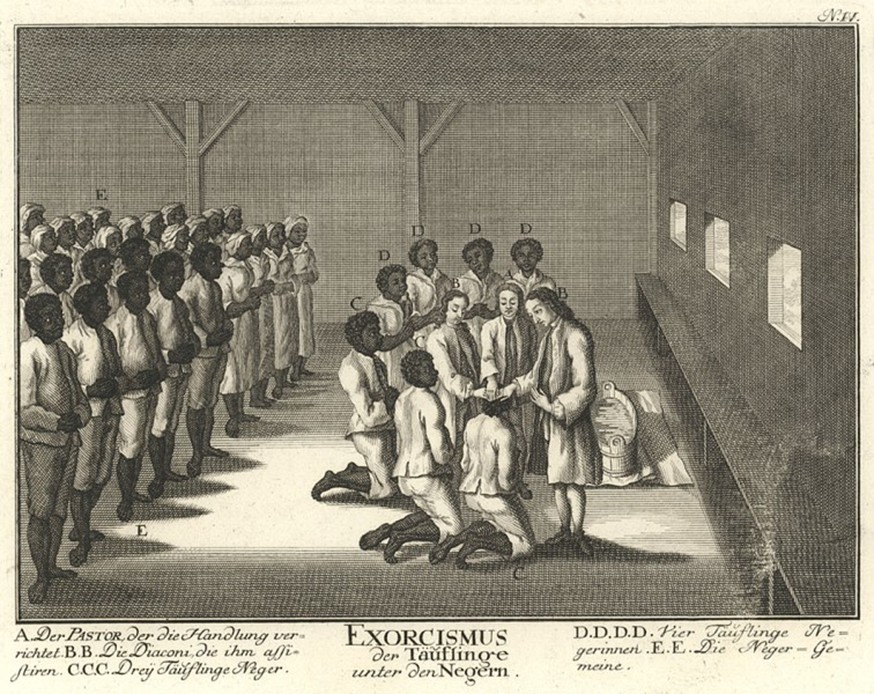
Early modern religious culture is both a producer and product of privacy. Beliefs constitute a space of negotiation, where privacy is carved out in the friction between abstract theological ideas and everyday practices. By closely studying individual cases, we can observe when religious practices produce privacy and how different states of privacy interfere with dominating religious views and ideologies.
Profile articles
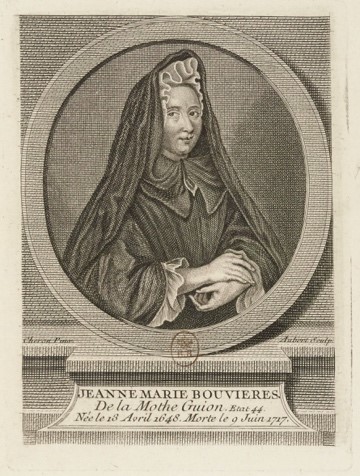 |
Bastian Felter Vaucanson, La conversation éternelle. L’intimité spirituelle dans la correspondance Guyon-Fénelon, PhD thesis, Principle supervisors: M.B. Bruun and F. Trémolières. Co-supervisor: L.C. Nørgaard, Copenhagen, Rennes: 2022. |
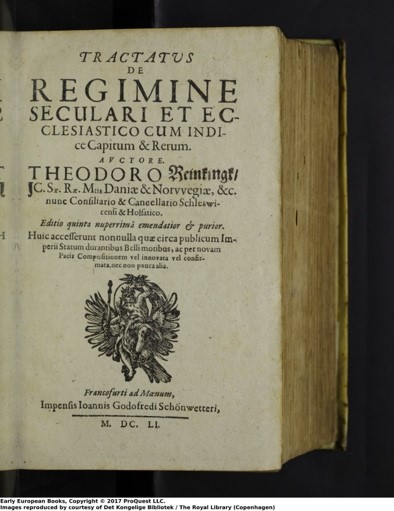 |
Paolo Astorri, Lars Cyril Nørgaard, “Publicus–Privatus The Divine Foundations of Authority in Dietrich Reinking”, Journal of Early Modern Christianity 9/1 (2022), 93-119. |
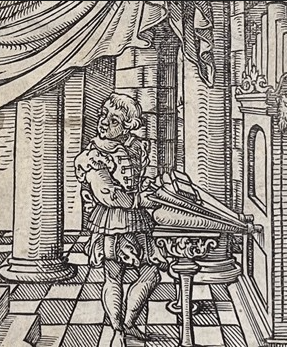 |
Søren Frank Jensen, Nicolaus Selnecker's Psalterbuch, 1563-1623. Addressing the Public – Voicing the Private, PhD thesis, supervised by M.B. Bruun (Principal supervisor) and L.C. Nørgaard (Co-supervisor), Copenhagen 2023. |
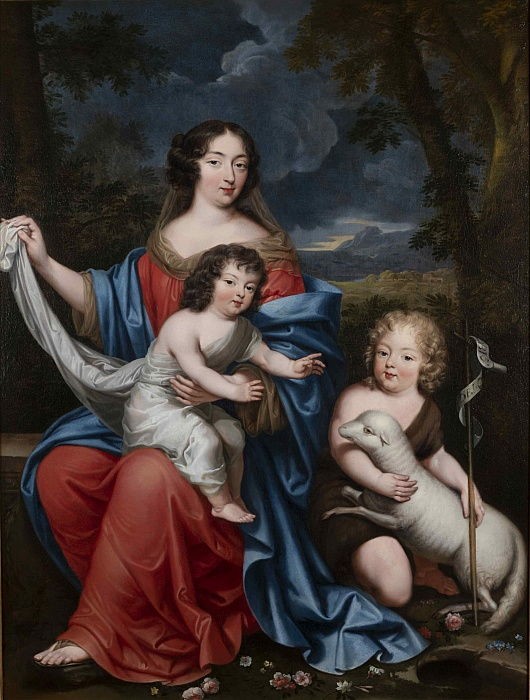 |
Lars Cyril Nørgaard, Les Petits Livres Secrets (Paris: 2023) |
Paolo Astorri, Lars Cyril Nørgaard, “Natural Law and Governance in Henning Arnisaeus” in W. Druwé, R. Lesaffer, G. Sluijs (eds.), Natural Law and Domestic Government, Studies in the History of International Law (Leiden: 2024).
Bastian Felter Vaucanson, La conversation éternelle: L’intimité spirituelle dans les lettres de Madame Guyon à Fénelon, 2024, (Accepteret/In press) Paris: Hermann. (Les collections de la République des Lettres).
Mette Birkedal Bruun, ”Cloistered Correspondences: Engaging and Renouncing the Grand Siècle”, in M. Green & L.C. Nørgaard (eds.), Notions of Privacy in Early Modern Correspondence (Turnhout: 2024).
Bastian Felter Vaucanson, Michaël Green, "Refractions of Privacy in Early Modern Letter Writing" in Michaël Green & Lars Cyril Nørgaard (eds.) Early Modern Correspondence: The Privacy Perspective (Brepols Publishers: 2024).
Lars Cyril Nørgaard, & Bastian Felter Vaucanson, Privacy Misconstrued? The Correspondence between Fénelon and Maintenon, (Accepteret/In press) Early Modern Correspondence : The Privacy Perspective. Michael Green & Lars Cyril Nørgaard (eds.). Brepols Publishers: 2024.
Bastian Felter Vaucanson, Nathalie Freidel (ed.), Judith Scribnai (ed.), Emma Gauthier-Mamaril (ed.), Le pouvoir de la faiblesse: L’éthos mystique de Jeanne Guyon à la lumière de sa correspondance, 2024, (Accepteret/In press) In: Tangence.
Mette Birkedal Bruun, Lars Cyril Nørgaard, “Au Milieu d’une Cour Superbe & Tumultueuse’ Devotional privacy at the Court of Versailles”, in D.M. Neigbors, L.C. Nørgaard, E. Woodacre (eds.), Notions of Privacy at Early Modern Courts. Reassessing the Public/Private Divide, (Amsterdam: 2024), 215-240.
Adam Horsley, “When Private Speech Goes Public: Libertinage, Crypto-Judaic Conversations, and the Private Literary World of Jean Fontanier, 1621”, in Tracing Private Conversations in Early Modern Europe. Talking in Everyday Life, ed. by Johannes Ljungberg & Natacha Klein Käfer, Palgrave Macmillan 2024, 59–80.
Jane McKee, ‘Privacy and Discretion in the Correspondence of Charles Drelincourt’, in M. Green & L.C. Nørgaard (eds.), Notions of Privacy in Early Modern Correspondence (Turnhout: 2024)
Lars Cyril Nørgaard, Bastian Felter Vaucanson, “Privacy Misconstrued? The Correspondance between Fénelon and Maintenon”, in M. Green & L.C. Nørgaard (eds.), Notions of Privacy in Early Modern Correspondence (Turnhout: 2024)
Virginia Reinburg, “Talking About Religion During Religious War: Gilles de Gouberville, Normandy, 1562”, in Tracing Private Conversations in Early Modern Europe. Talking in Everyday Life, ed. by Johannes Ljungberg & Natacha Klein Käfer, Palgrave Macmillan 2024, 33–57.
Oskar J. Rojewski, ”The translation of court culture from the Burgundian Court to the Kingdom of Castile: The sovereign’s privacy and relationship with court artists”, in D.M. Neigbors, L.C. Nørgaard, E. Woodacre (eds.), Notions of Privacy at Early Modern Courts. Reassessing the Public/Private Divide (Amsterdam: 2024), 163-190.
Paolo Astorri, ”The Redefinition of Clandestine Marriage by Sixteenth-Century Lutheran Theologians and Jurists”, Law and History Review 41/1 (2023), 65-92.
Bastian Felter Vaucanson, "Between Faith and Work: Fénelon's Conception of Charity for a Monarch". French Historical Studies vol. 46 (2023), no. 1: pp. 37-55.
Paolo Astorri, Lars Cyril Nørgaard “A little Republic. The conceptualisation of the household according to Henning Arnisaeus (1570-1636)”, in B. Holm & N. Koefoed (eds.), Reformation and Everyday Life, (Göttingen: 2023), 195-220.
Jesper Jakobsen, Lars Cyril Nørgaard, “Changing Reasons of Censorship? The Faculty of Theology of Copenhagen University (1740-1770)”, in J. Ljungberg & E. Sidenvall (eds.), Between reason and orthodoxy: Religious Enlightenment in the Nordic Countries, c. 1680–1820, (Manchester: 2023), 287-311.
Johannes Ljungberg, “Sabbath Crimes in a City of Enlightenment. Religious and Commercial (dis)order in mid-eighteenth-century Altona”, in J. Ljungberg & E. Sidenvall (eds.), Between reason and orthodoxy: Religious Enlightenment in the Nordic Countries, c. 1680–1820, (Manchester: 2023), 312–40.
Paolo Astorri, Søren Frank Jensen, ”Heinrich Hahn (1605–1668). A Portrait of a Lutheran Jurist at the University of Helmstedt”, Zeitschrift der Savigny-Stiftung fur Rechtsgeschichte, Kanonistische Abteilung 108/1 (2022), 204-242.
Anni Henriksen, The Private Mind in Elizabethan England: Representations of the Mind in Literary, Political, Religious, and Legal Discourse”, PhD dissertation, supervised by M.B. Bruun and A.Brett (Copenhagen: 2022).
Lars Cyril Nørgaard, “Copie ou Création? Les petits livres secrets de Madame de Maintenon”, in “Toute la cour était étonnée”: Madame de Maintenon ou l’ambition politique au féminin, actes du colloque, eds. M. da Vinha & N. Grande. (Rennes: 2022), pp. 137-148.
Paolo Astorri, ”Can a judge rely on his private knowledge? Early modern Lutherans and Catholics compared” , Comparative Legal History 9/1 (2021), 56-88.
Maarten Delbeke, “Privacy and Exemplarity in Gianlorenzo Bernini’s Cornaro Chapel”, in M. Green, L.C. Nørgaard, M.B. Bruun (eds.), Early Modern Privacy. Sources and Approaches (Leiden: 2021), 317-363.
Walter S. Melion, “Jesus, Mary, and Joseph as Artisans of the Heart and Home in Manuscript MPM R 35 “Vita S. Joseph beatissimae Virginis sponsi” of ca. 1600”, in M. Green, L.C. Nørgaard, M.B. Bruun (eds.), Early Modern Privacy. Sources and Approaches (Leiden: 2021), 317-363.
Natacha Klein Käfer, ”Dynamics of Healer-Patient Confidentiality in Early Modern Witch Trials”, in M. Green, L.C. Nørgaard, M.B. Bruun (eds.), Early Modern Privacy. Sources and Approaches (Leiden: 2021),281-296.
Lars Cyril Nørgaard, ”Making Private Public”, in M. Green, L.C. Nørgaard, M.B. Bruun (eds.), Early Modern Privacy. Sources and Approaches (Leiden: 2021), 378-400.
Lars Cyril Nørgaard, Eelco Nagelsmit, “Ah! Mignard que vous louez bien !”: Le secret et le sacré dans le portrait de Madame de Maintenon” Bulletin du Centre de recherche du château de Versailles. Sociétés de cour en Europe, XVIe-XIXe siècle (2021)
Lars Cyril Nørgaard, “Levels to ekphrasis in the Tableaux de la Pénitence”, in A.J. DiFuria & W.S. Melion (eds.), Ekphrastic Image-making in the Early Modern Europe, 1500-1700, (Leiden: 2021), 410-482.
Lars Cyril Nørgaard, “Overvejelser over en ligprædiken” Kirkehistoriske Samlinger, 2021, p. 7-39
Natália Da Silva Perez, Peter Thule Kristensen, ”Gender, Space, and Religious Privacy in Amsterdam”, TSEG - The Low Countries Journal of Social and Economic History 18/3 (2021), 75–106.
Anne Régent-Susini, “How to make exemplarity with secret virtues”, in M. Green, L.C. Nørgaard, M.B. Bruun (eds.), Early Modern Privacy. Sources and Approaches (Leiden: 2021), 179-193.
Lee Palmer Wandel, ”The Moment of Communion”, in M. Green, L.C. Nørgaard, M.B. Bruun (eds.), Early Modern Privacy. Sources and Approaches (Leiden: 2021), 159-178.
M.B. Bruun, M. Green, L.C. Nørgaard, “En privé & en public. The Epistolary Preparation of the Dutch Stadtholders” Journal of Early Modern History 24.3 (2020), 253–279.
Current projects
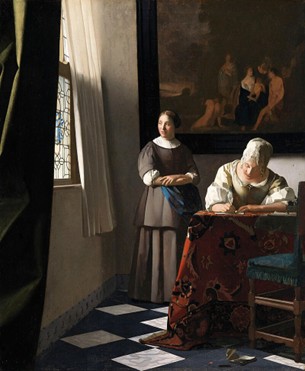
Letters offer a particularly rich source for exploring early modern privacy, as they are both highly contextual and personal. As objects in constant flux, letters allow us to trace how privacy emerged through interpersonal interactions and examine the kinds of experiences this privacy enabled and shaped. The spiritual letter, an epistolary genre that spread and evolved rapidly in the wake of the confessional reforms of early modern Europe, exemplifies this dynamic. Although such correspondence was always personal, its degree of privacy and intimacy could vary significantly. By analyzing the differences and similarities in exchanges between spiritual directors and their spiritual "children," we can discern how letters functioned as tools for carving out private spaces. Within these spaces, negotiations of social status, particularly around gender and class, unfolded through spiritual communication, creating conditions in which cultural norms and power structures are both reinforced and subverted.
Members: Bastian Felter Vaucanson, Lars Cyril Nørgaard, Michaël Green, Alexander Mkandawire, Mette Birkedal Bruun, Jane McKee, Anne Régent-Susini and Luc Vaillancourt
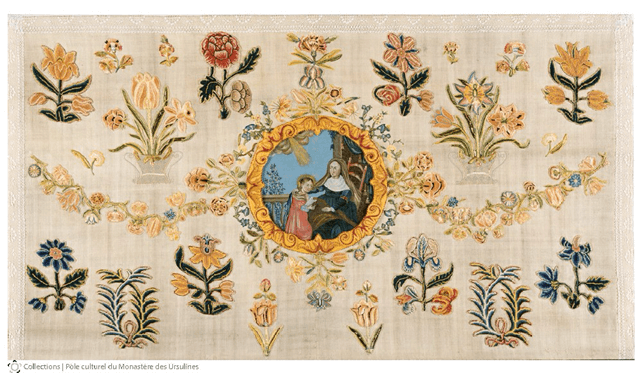
Altar frontal known as ‘The Education of the Virgin’, 17th century, Pôle culturel du Monastère des Ursulines de Québec, 1995.1091 (photo: Michel Élie), reproduced with permission.
Nuns at the End of the World (NEW): Cross-Cultural Contact in Seventeenth-Century Québec was an individual postdoctoral research project financed by the Carlsberg Foundation’s Internationalisation Fellowship (631.347,- DKK, app. 85.000 Euros) to Bastian Felter Vaucanson in May 2023. The project, which ran out in 2024, explored the archives of the Ursuline convent in Québec and was carried out in collaboration with the Centre interuniversitaire de recherche sur la première modernité (CIREM 16-18).
The colonial context generates its own privacy-related dynamics. Part of the French missionaries’ strategy of evangelization was to penetrate the private spaces – both physical and symbolic – of the Indigenous. But privacy also works the other way around and can operate in defiance of such attempts to regulate and control. Scholarship has identified Indigenous religious ceremonies, beliefs, and imaginations as significant. By rejecting missionaries access to the meaning-making aspects of spiritual practices and religious ceremonies, religious leaders create spaces of privacy that protect certain kinds of intimacy
By studying the rich collection of devotional objects in the Ursulines convent, NEW explored how European and Indigenous private devotional practices blend and influence each other.
Related PRIVACY projects: Spiritual Intimacy in New France, Privacy and Letter Writing, Privacy Black and White, Privacy at Sea, The Danish Mission to Greenland
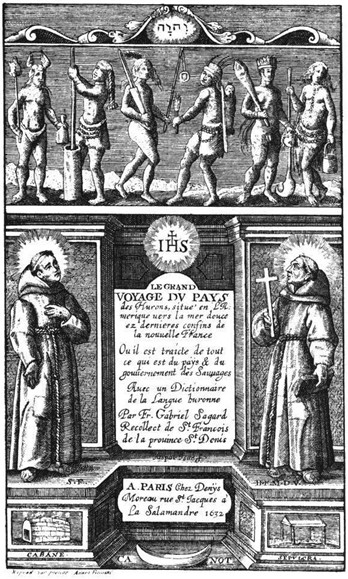
Frontispiece to Gabriel Sagards Le Grand Voyage du Pays des Hurons, Paris: Chez Denys Moreau (1632).
Organized by the Centre for Privacy Studies, the Research Chair for Indigenous Discourse (University of Québec in Chicoutimi), and Formes et Idées de la Renaissance aux Lumières (Sorbonne Nouvelle), Intimacy and Spirituality in New France/Intimité et spiritualité en Nouvelle France was a bilingual interdisciplinary workshop in Octobre 2024, followed by a proposal for a special issue of Renaissance and Reformation/Renaissance et Réforme, currently under review.
The special issue unites historians, church historians, historians of literature and archaeologists from Canada, France and Denmark. Each author is free to choose their methodology and sources, but the theme of intimacy brings a particular privacy-related dynamic of early modern colonial society to the fore: That specific point in place and time when an “individual” meets “society” and boundaries are being traced between them. In early modern Europe, intimacy is theorized in theological and rhetorical terms. By introducing spirituality as the second strand of our shared investigation, we wish to enquiry into the reciprocal impact of notions and practices of intimacy and religious beliefs and imaginations in the broadest sense, allowing for an approach that includes Indigenous as well as European experiences. Above all, we are interested in the tensions that arise when boundaries are drawn around intimacy by means of spirituality.
Members: Bastian Felter Vaucanson, Anne Régent-Susini and Luc Vaillancourt
Connection to other research projects at PRIVACY: NEW, building early modern privacy,
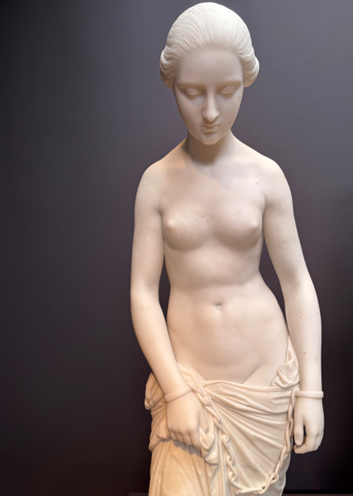
- A. Jerichou, Slavinden, 1855, Ny Carlsberg Glyptoteket, Copenhagen.
Organized by the Centre for Privacy Studies in collaboration with the Centre for Practiced Based Art Studies (PASS), Privacy and Slavery Past and Present: Academic and Artistic Approaches to Knowledge-Production is a series of workshops and a three day conference-exhibition taking place in 2026. We invite academics and artists to engage with the theme in a spirit of open-minded curiosity and creative approaches to knowledge-production with the aim of generating new knowledge about practices of enslavement and the ways in which privacy has been and continues to be used as a means of social resistance and control. How notions and practices of privacy shape relations between individuals and communitites when the use of enslaved labour is part of the social status quo?
Throughout all its manifestations, the structure of enslavement is designed to maintain control over people through the privation of rights. As such, privacy may seem a distant concept to enslaved people both past and present. What is private in a setting of constant surveillance? Can a kinship bond be private whilst commodified? And how is it possible to raise questions about the privacies of those who leave very few records of their own and have much of their lives under control of others?
Privacy and privacy related phenomena such as intimacy, secrecy, family, and domesticity existed and mattered in contexts and ways we might intuitively think unimaginable. Although conventional ideas of privacy might seem almost intuitively opposed to life under enslavement, this does not mean that enslaved people will simply submit to doing without it.
The call for papers will be published in the second half of 2025. Stay tuned on PRIVACY’s website for more information!
Members: Bastian Felter Vaucanson, Hannah Katharina Hjort, Francis Ethelbert Kwabena Benyah, Anne-Julie Arnfred, Mette Birkedal Bruun, Mikkel Bogh
Institutional collaborations: Centre for Practiced Based Art Studies, University of Copenhagen.
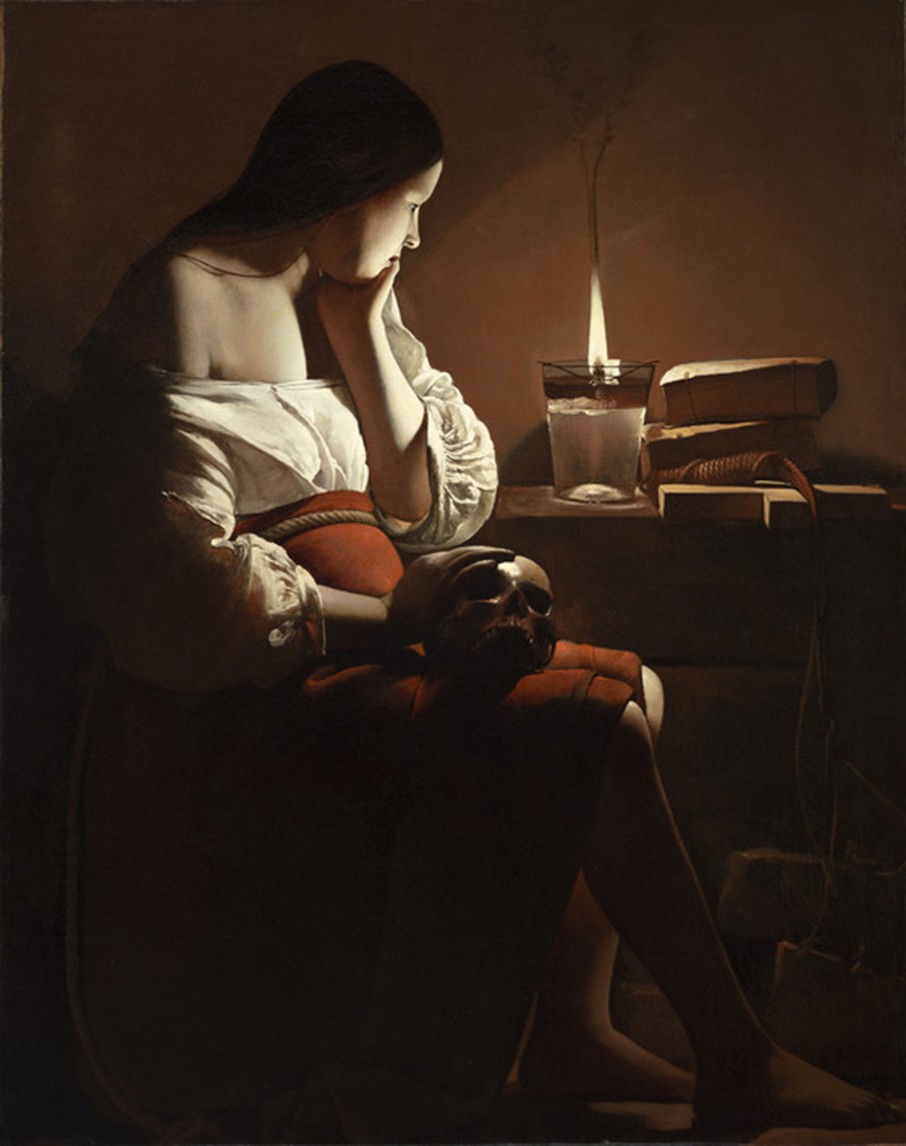
George de la Tour, The Magdalene with the Smoking Flame, c. 1635-1640. Los Angeles County Museum of Art, M.77.73. https://collections.lacma.org/node/238963
The Night as a Private Space: Darkness, Secrecy, and Shadows in the Early Modern Period and Today is an interdisciplinary conference organized in collaboration with Institut für Dänish at the University of Flensburg. The event takes place on 11-12 December and will lead to a collected volume targeted to De Gruyter publishing house.
How does the night impact privacy? Which activities and creative potentials become available and/or acceptable under the cover of nocturnal darkness? Is the night more private than the day? How have these dynamics changed from the early modern period until today? In this two-day international conference, we invite scholars from all historical fields and all career levels to engage with the early modern night from the interdisciplinary perspective of historical privacy studies. Our aim is to reconsider the night in contemporary late capitalist society, where the 24/7 lifeworld is, arguably, steadily undermining the distinctions between night and day, between light and darkness, between rest and action.
Obscure, opaque, and occult, the early modern night comes across as a privileged space of privacy and solitude. Perceived at once as a threat and a value, the night transforms social space into a mirror world of shadows populated by twilight beings such as demons and angels, genies and ancestors. If, since antiquity, the night has born death and sleep as her children, the tomb-like stillness of the shadowy embrace is deceptive. In the densely populated urban areas of the early modern world, privacy was hard to come by for the vast majority. As prohibitions that obtain during normal day-time activity are lifted, night-time leaves room for alternative sensory experiences, social relations, and mental projections that are often accorded no existence during daytime. Is this still the case today?
The Call for Papers closes 15 July 2025. It can be accessed .
Publication: Bastian Felter Vaucanson and Søren Frank Jensen, “Kristus Corpscore. Black Metal i et kirkehistorisk perspektiv”, in Skriget ved Verdens ende (red. Markus Floris Christensen), Copenhagen: Multivers, forthcoming.
Members: Bastian Felter Vaucanson, Markus Floris Christensen
Privacy and Belief Today
The BELIEF theme engages with religious institutions and communities, and collaborates with artists, public intellectuals and civic organizations to nuance present-day issues and debates that have roots in the Christian tradition. We do not suggest finite answers, nor do we take a stance on religious questions. Instead, we offer our expertise to those interested in gaining church historical perspectives on present-day topics. Historical privacy studies functions as an analytical tool that brings new and unexpected layers of complexity to the fore.

Martin Eder, Will some God please come, 2024. Reproduced with permission from the artist. https://martineder.com/works/can-some-god-please-come-2024/
Black Metal Privacy
This project applies the methods and insights from historical privacy studies to the Scandinavian Black Metal culture of the late 20th and early 21st centuries. Within the framework of a co-authored book chapter in the collective volume Skrigets ved verdens ende (The Scream from the End of the World) – edited by Markus Floris Christensen and published by Multivers – the work explores experiences and representations of rupture between the individual and the collective in a diachronic juxtaposition of Black Metal with early modern mystical writings and mine worker sermons. As reflected in the main title – “Kristus Corpscore” (Christ Corpscore), which refers to Black Metal’s aesthetic ideal of “corps sound” –, the article delves into the paradoxes and ambiguities of religious imaginations, using privacy in an attempt to come within touching distant of the glorious darkness radiating from the grave of the dead God.
Members: Bastian Felter Vaucanson, Søren Frank Jensen, Markus Floris Christensen
Privacy and Trauma
Guilt and Reconciliation: Individual and Collective Perspectives on the Traumas of the Past is a one-day seminar aimed at pastors in the Danish Folk Church (Folkekirken) uniting experts from the fields of rhetoric, philosophy, law, economics and theology to discuss guilt and reconciliation from a privacy angle. Taking place 14 August 2025 at the Faculty of Theology, the seminar will ask how we relate to the darkest chapters of the past, and who bears the responsibility. Do we as individuals and/or as a society, carry the guilt for the traumas caused by the abuses of our predecessors? And how do we take responsibility for reconciliation?
Programme:
Bastian Felter Vaucanson, Ph.D., Assistant Professor, Centre for Privacy Studies:
"Welcome and Introduction"
Lisa Villadsen, Ph.D., Professor, University of Copenhagen:
"When the State Apologizes"
Amalie Drage Habbestad, MA in Indigenous Studies, Ph.D. Candidate, Arctic University of Norway:
"Different Perspectives on Reconciliation from the Nordic Truth and Reconciliation Processes"
Ulrica Fritzson, Ph.D., Bishop of Skara Diocese, Church of Sweden:
"Merciful Reconciliation – On the Demand for Acknowledgment of Guilt and the Voluntariness of Forgiveness"
Thomas Brudholm, Ph.D., Associate Professor, University of Copenhagen:
"Guilt and Reconciliation from a Victim’s Perspective"
Agnete Vienberg Hansen, M.Sc. in Economics, Ph.D. Fellow, University of Copenhagen:
"Guilt and Reconciliation in the Age of Neocolonialism"
Frederik Harhoff, Doctor of Law, Professor Emeritus, University of Southern Denmark and Former Judge:
"Hatred, Guilt, and Responsibility Between Perpetrators and War Victims"
Sigrid La Cour Sonne, M.Th., Theological Consultant, Church of Denmark and Interfaith Dialogue:
"Does the Majority Church Have a Responsibility Toward Religious Minorities? Experiences from the Church of Denmark in Interfaith Dialogue"
WORKSPACE
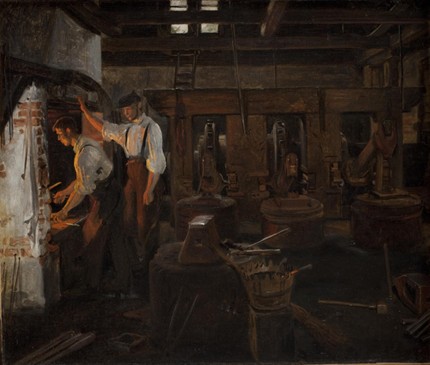
Constantin Hansen, Det indvendige af den gamle hammermølle ved Hellebæk, 1859, Statens Museum for Kunst, Copenhagen.
Shaping Workspaces with Religion in the Danish Atlantic, 1733-1807 (WORKSPACE) is an individual research project financed by the Carlsberg Foundation’s Reintegration Fellowship (1.9 mill. DKK, app. 260.000 euros) that explores the interference of religion and work on a Caribbean sugar plantation and a Danish estate. It studies how religious practices and imaginations influenced the organization of these spaces and how they were used by both the powerful and the oppressed to control or resist social structures.
WORKSPACE explores the role of the church and Christianity in shaping private spaces in rural and urban contexts across the Atlantic in the 18th-century Danish kingdom. WORKSPACE applies spatial analysis to study the Moravian plantation of Posaunenberg in St. Thomas and the Schimmelmann estate Hellebækgård in Northern Zealand. Through these two cases, the research will reveal how religion organized daily life, power relations, and subtle forms of resistance in these environments.
The research is oriented toward historical sources but also takes into consideration their aftereffects and the ways in which the past “sticks” to the present. The project partly stems from an interest in the role and significance of Christians Church in the urban space of Christianshavn in Copenhagen. The church was built by German merchants in Copenhagen who became immensely wealthy through the trade of sugar, weapons, and people. Surrounded by a shipyard, a sugar refinery, and a warehouse, and overlooking the state-sponsored trading companies, the church towers like a phallic monolith at the end of Strandgade –Wall Street of 18th-century Copenhagen. The building thus bears witness to Christianity’s historical entanglement with the systematic abuse of human labor in global capitalism. Christian’s Church is just one striking example among many of the church as a generator of social realities, where bodies are constrained and directed.
A central part of the project is a field study to the US Virgin Islands, St. Thomas and St. Croix, through which I will examine how theological knowledge is not only produced in academic settings but also in cross-aesthetic, cross-disciplinary, and cross-cultural contexts. Liturgy, ethics, and spirituality intersect and open up new forms of understanding.
This ambition will initially be realized through an interdisciplinary event in the form of a conference, exhibition, or happening, tentatively scheduled to take place in November 2026 in collaboration with the Novo Nordisk Foundation Center for Practice-based Arts Studies at the Department of Arts and Cultural Studies, University of Copenhagen. Uniting scholars and artists, the event will be on the topic “Slavery Past and Present: Academic and Artistic Approaches to Knowledge Production”.
Members: Bastian Felter Vaucanson
Connection to other PRIVACY research project: Privacy and slavery,
Institutional collaborations: United States Virgin Island Caribbean Cultural Center (University of Virgin Islands), Friends of Denmark, Dansk-Vestindisk Venskabsforening, Hellebæk lokalhistorisk forening.
Partner projects
 |
VIVE Det Nationale Forsknings- og analysecenter Together with Thorben Peter Høj Simonsen at VIVE, we are attempting to develop a novel framework for studying how past privacy was and continues to be translated in architectural terms: we focus on present-day and purpose-built spaces like, e.g., psychiatric hospitals and prisons, where we will test our historical approaches. |
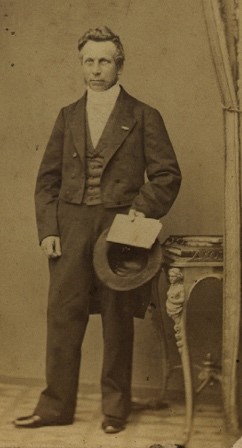 |
Section for systematic theology, University of Copenhagen With Elizabeth Xiao-An Li at the Section for Systematic Theology, we study the Danish philosopher Rasmus Nielsen (1809-1884), who developed a system of the sciences, where church history played an important role. We aim, historically, to contribute to the further refinement of the interdisciplinary approach pioneered at PRIVACY. |
|
The Danish National Security and Intelligence Service BELIEFS has established contact with the Director of Counter-Terrorism, Henrik Bjelke Hansen, who, since December 2020, has headed a group comprising several experts and investigating the dynamics of radicalization in Danish society (the so-called Bjelke-group). We will learn from Henrik, his present-day approach to the ambiguities of privacy, and discuss our historical approach with him. |
|
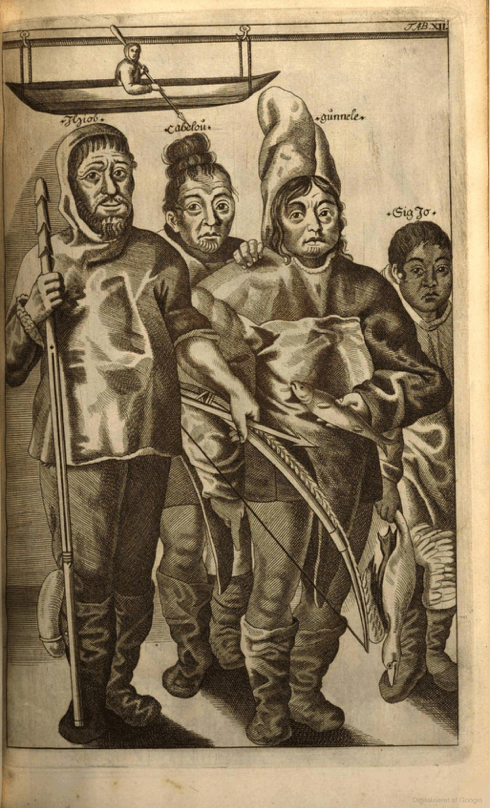 |
The Missions to Greenland This PhD project studies how encounters between missionaries and the inuit developed from the 18th century until 20th century. These encounters are prisms for the (mis-)translation of identities and concepts, including notions of the private and the personal. Alexander’s project will combine close analysis of sources with the methods developed at PRIVACY. |
 |
Nuns at the end of the world (NEW): Cross-cultural contact in 17th-century colonial Québec Bastian Felter Vaucanson's Internationalisation Fellowship, granted by the Carlsberg Foundation, explores French Ursuline nuns in colonial Quebec in the 17th century, with a focus on cross-cultural exchange between the nuns and the Indigenous people. |
Presentation of theme leader, Bastian Felter Vaucanson
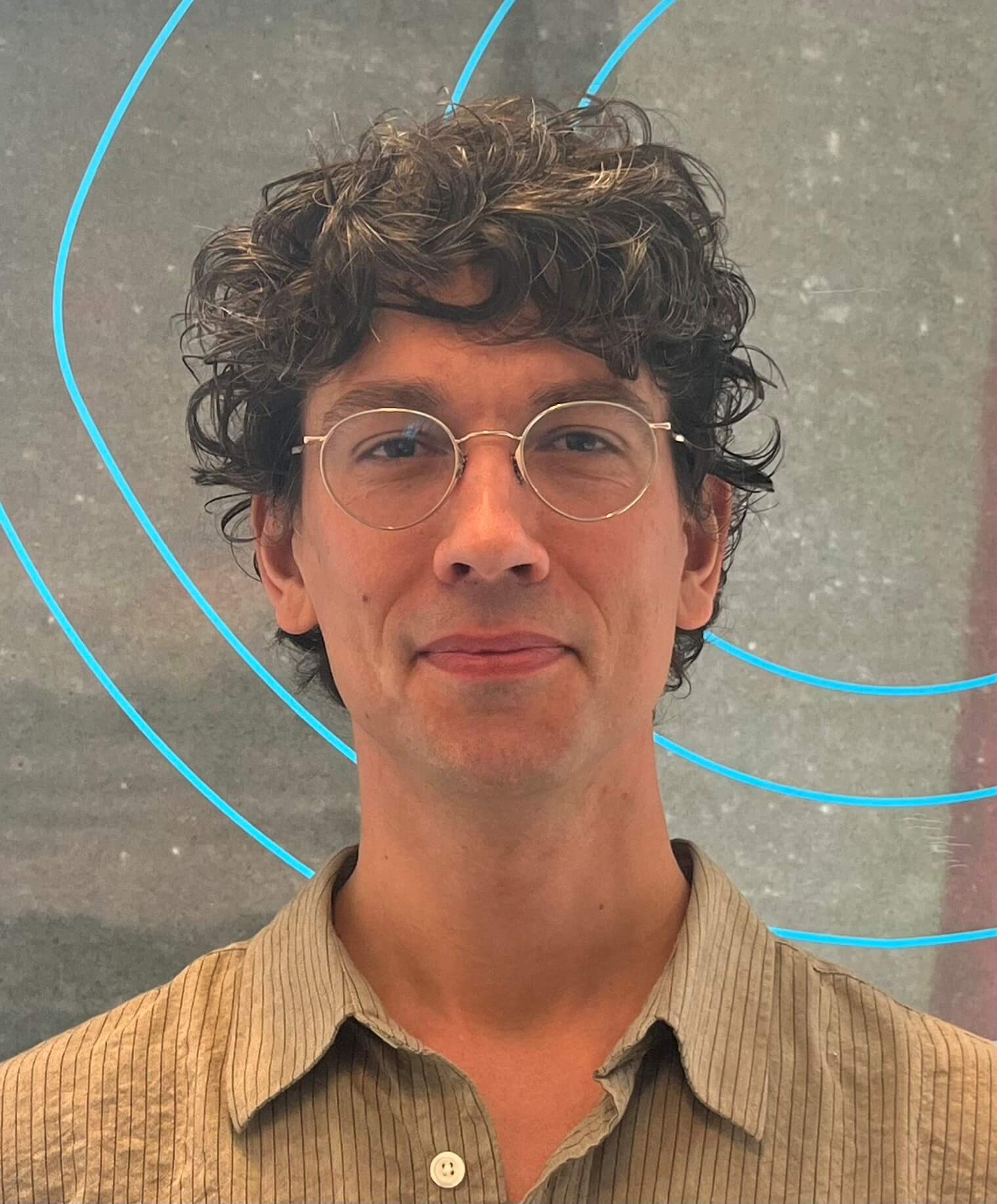
I am a church historian specializing in mysticism, intimacy, and mission. My work spans the European, Canadian, and Caribbean contexts, with a particular interest in how religious imaginations and practices both shape and are shaped by social space. My current research project (WORKSPACE) explores this dynamic through a comparative study of the impact of religion on everyday work life on a Moravian sugar plantation and in a pre-industrial Danish village.
Read more about my research here.
